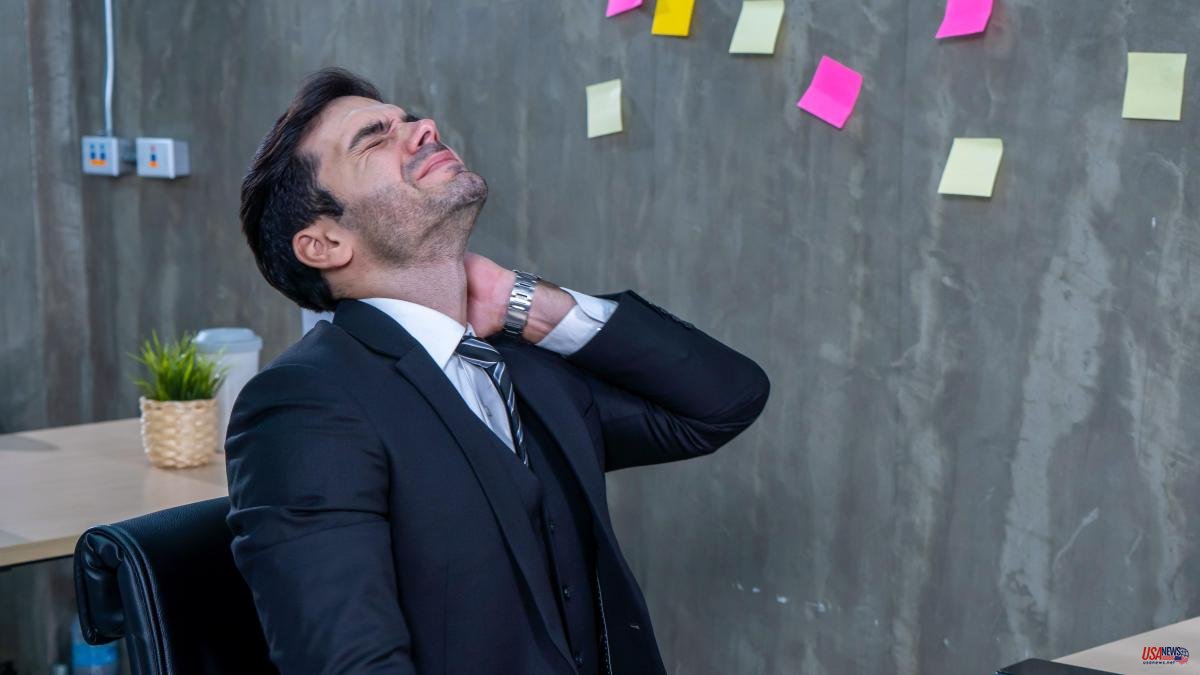How many times have we not blamed our neck and back pain on the posture we have for hours of sitting due to those endless hours of work. Raise your hand if you haven't! And it is not for less, it is logical. But it is a frequent mistake, because the bad thing is not the posture, it is the fact of not moving, says the French osteopath Julien Leprêtre, one of the authorized voices in this field, creator of the Functional Method and also a personal trainer specializing in prevention. of injuries.
In her book Moving without pain (Vergara publishing house), Leprêtre, who has more than a million followers on social media, intuitively explains how the body works and how we can alleviate its tensions. And he does it based on two basic principles. One, we don't have to live with pain or chronic fatigue or resign ourselves to discomfort. And, two, whatever position we adopt, that will not be the cause of pain. Leprêtre insists on the need to move frequently, since it is the best food for our joints, even if it is only 30 seconds several times a day. We spoke via zoom with the physiotherapist and disseminator of life in motion.
Pain is optional, he says, but can we avoid it?
It's a bit of a shocking line that I said, although, obviously, it's not really optional. Pain is an alarm signal that is necessary. What is optional is waiting for him to leave, and that does not have to be done. It's like when the alarm goes off in your house, you have to do something. And there are three strategies that we can apply before that alarm
Which are?
We can try to cover up the noise, with medication, stretching or try to relieve pain and that helps to return to our activities, but it is not the only strategy. There are others that are important, such as, for example, correcting the causes that triggered that alarm: it is not always easy because many causes are always involved in pain, what social networks or many therapists sell is a cause, they find you one cause and they say 'there it is', we fix that and you'll be better. But that doesn't work that way, otherwise we would already know what the appropriate treatment for the hernia is. No, the cause of pain is multifactorial, there are many, and you have to try to correct them all. They can be emotional causes, our lifestyle, food, sedentary postures...
And the third strategy?
It's what I teach in my book, try to improve the function of your body. Even if you have pain, you can always improve your mobility, the movement of your joints, that range of motion that you will have before the pain appears. We can also improve strength, be more able to push until the pain comes, pushing our limits a little bit, of mobility, of flexibility, of strength so that we can do much more. And with that we improve the tolerance of the body and pain and improve.
Are not the postures to blame for many pains?
No. Before, it was thought that the positions were bad, we didn't like them, they are not aesthetic and they cause back pain. But it is the correlation that makes us think that the cause comes from the posture, and it seems logical. However, based on scientific evidence, what is logical is not always true and thanks to studies carried out in the last ten years we have realized that changing the posture does not change pain much. There are many people who suffer from pain both with the straight position and with a stooped posture. Therefore, the culprit is another, it is not the posture, it is the sedentary lifestyle. In other words, posture is not a cause, it is a consequence, just like pain, so changing your posture is not going to decrease pain. For this to happen you have to fight against the real causes and those come from a sedentary lifestyle. And if we correct that, we will not only reduce the pain, but also that hunched-over posture that we don't like.
So, does the posture matter, even if we spend many hours with the same one, wrong or correct?
There are positions that are more comfortable than others. If now that you are sitting, I ask you to straighten up and maintain that position for eight hours, it will be impossible for you to do so, your muscles will tire faster than your ligaments or your intervertebral discs and you will end up hunching your back to do rest your muscles a bit. That will go well for a while until the ligaments and intervertebral discs begin to wake up a bit, which receive a lot of pressure and support loads for much longer than muscles. After two hours they are already tired, they need to move, change position, rest a little and that's why pain appears. If you change position again or get up and walk around a bit, do movements, you can allow the discs and ligaments to rest.
Do you advise that movement is better for pain? Always? Or do you have to know when to stop?
Movement is always better, but what matters is the intensity of the movements. You can always move around a bit, even when you have low back pain, a locked back or neck, and a stiff neck. There is always a minimum of mobility and you have to keep using it. I'm talking about the comfort zone, that area where there is no pain, we need to use that range of motion as much as possible so that it gradually increases and helps us improve tolerance. Of course, there is a limit and it must be understood what are those of each person at each moment, which may be different today and tomorrow. You have to use the comfort zone without forcing it by listening to our body because looking for more than what can be done at that moment can be dangerous and increase the risk of injury.
There is always fear of pain and we prefer not to move
Yes, and it is the big risk. 20 years ago, when someone got a blockage in their lower back, the doctor told them: “stay in bed and don't move”. Now we know that it is the worst advice we can give someone. For example: now when we put a knee or hip prosthesis on a person, the next day we ask the patient to start walking, we start with active rehabilitation, which is what will stimulate healing and that will make the tissues adapt. If you remain immobile, without doing anything, there is no adaptation and the body will get worse. That's why you have to maintain mobility. But the movement must be done consciously, because you may have to let the tissues where it hurts rest, but not those around it, those must be moved. For example, someone who has a knee injury and can't walk can train their upper body, work their arms, and even do cardio without using their knee.
Although what is being worked on is the upper part and not the lower part, which is the one that is injured?
Exactly, because healing is much more than a tissue that wants to heal, it is a cardiovascular system that will improve its work, that will send blood to the area, each muscle contraction will improve blood circulation and that is very beneficial for the body, for recovery.
Does sitting feel good to the human body?
What does not go well is not moving. Whatever the immobility. For example: if you stand still without moving, after a while it will hurt, regardless of your posture. Like if you lie on your back in a bed after an operation and can't move for weeks. That is why physiotherapists are employed in hospitals, who go every day to stimulate the muscles and manipulate the joints because the body cannot stand immobility, it is a machine that needs movement to live.
In the book you talk about how the body needs movement in the same way that it needs food. What kind of movement are you referring to?
Any type of movement is good, we have muscles in all parts of the body and all parts of the body need it. We can be very active, move around, but at the same time have sedentary muscles. For example, a waiter who walks a lot and stands all the time will always use the same arm to carry the dishes and at the end of the day there will be muscles that hurt a lot, hence the importance of mobilizing all the muscles of the body.
Does the time we have to move those muscles matter?
You have to work on mobility, strength. We need to move every muscle all day but we also need to rest a little. So it depends a lot on the time that each person has. The more, the better. It is not about doing fitness training for all muscles either, you just have to keep them active and you don't need to make very big and difficult efforts for it to be beneficial. For example, walking 20-30 minutes a day is the best thing you can do for your cardiovascular system, because it stimulates many muscles, not only those of the legs, but those of the back, shoulders... The ideal would be to have a light physical activity that do not be very strong throughout the day, multiply the small soft movements and three to four times a week have slightly more difficult workouts.
Is there one or two exercises that anyone should do yes or yes?
We are all very different, we develop different bodies because our bodies depend on everything we did during our lives and what we do today and especially what we don't do, but we can make generalizations. There are many people who work sitting all day, they would do well to work on compensating their back muscles with back extensions. For example: you can lie face down on the floor, place your hands behind your head and try to raise your shoulders and chest off the floor, this will activate all those erector spinal muscles that we don't usually work and allow them to compensate for all this stooped posture that we are going to have during the day.
Any other basic exercises?
Another simple exercise. Once seated, we raise our elbows out, we are going to push our elbows back, straightening our spine and sticking out our chest, then we get into the cactus position, we raise our arms up above our heads. We can repeat that movement 10-15 times to activate the rotator cuff muscles and the erector spinae muscles. They are ideal exercises for people who are very sedentary during the day.
Does our age influence the type of movement we have to do?
Age influences because we lose abilities over time, but the types of movement we need to do are the same, although they depend a lot on your abilities, if you have a very good lifestyle, take care of your body, keep moving, working on strength of your muscles... If you maintain a good muscle mass in your muscles at 80 years of age, you will be able to continue working on strength, doing the same exercises as at 30 years of age, it may be that not with the same intensity but the same movements yes. But if you do very little, do not take care of your body now that you are young, aging will affect you much more.
Is there an age to start moving?
Age does not matter much, what matters is the intensity, you have to maintain an acceptable intensity for your body and that it can withstand it. And that is learned with practice, that's why I always suggest starting with a very light intensity, gentle exercises and gradually increasing the difficulty professionally. A piece of advice for people who want to start moving is to start looking for something they like and that they will be able to continue practicing week, month and year, because movement and taking care of your body is not a short-term career, it is a long-term one. , we have to do it often, every day, it is a style that we want to learn to have. Because if it's something you don't like to do, after two or three months you will surely stop.
Are there basic movements that we can do every day?
My favorites are the wake up and bedtime routines. For example, from the age of 35-40 when we wake up we don't feel as light as when we were at 30, we begin to feel contractures in the body that are normal. That is why after eight hours lying in bed it is advisable to prepare the muscles for physical activity, even for the simple fact of standing up and supporting the weight of gravity. A good way before getting up and putting your feet on the ground is to do hip, lower back and shoulder movements to increase the cardiovascular system, they are not fitness movements, they are very soft and are simply an awakening of the joints and muscles.













